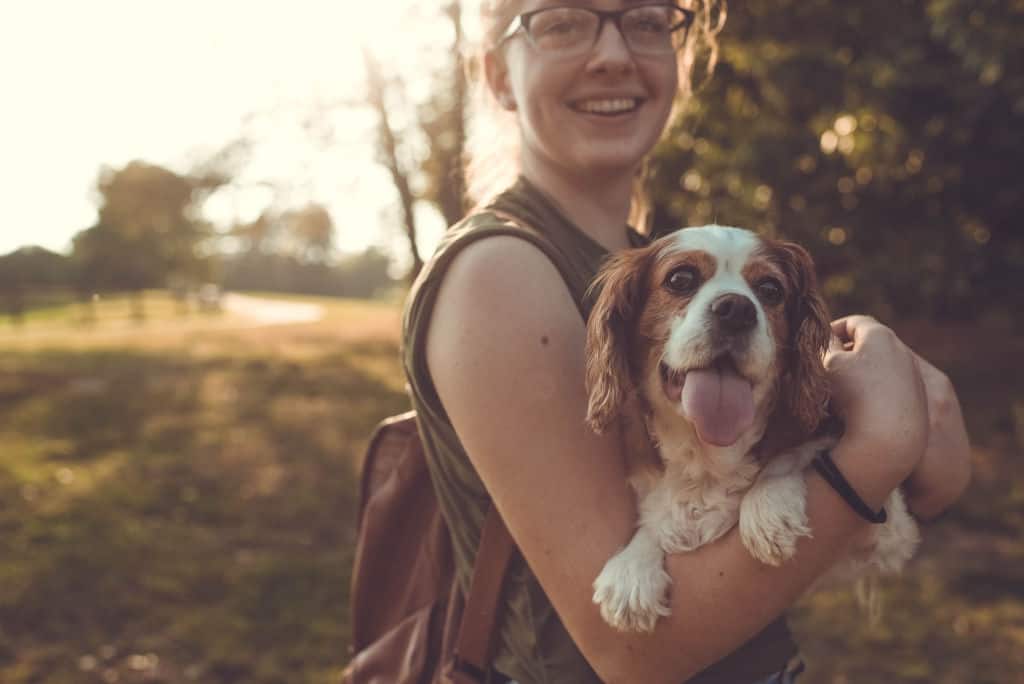Having a dog should be a fun and rewarding experience.
Starting out with a fear of dogs and then getting a puppy is not a good strategy. It might work, but it’s a backward approach that risks backfiring. So, if you are genuinely afraid of dogs, don’t get one just yet.
You must be self-assured to show your dog the world and make him feel safe with you. Fortunately, there are many things you can do to help yourself and overcome your fear before getting a dog.
In this article, we’ll help you figure out what you can do to accomplish this and eventually get a dog and build a loving relationship. You will begin with exposure.

1. Exposure to dogs is a great start
You have to begin somewhere. And the solution is at your local animal shelter. First and foremost, you’ll need some gradual and controlled exposure to puppies and small dogs.
Meet some of the dogs at your local pet shelter. Because they’re in kennels, you’ll be less likely to be around an aggressive dog and meet a variety of dogs with varying temperaments.
You can start by visiting the shelter every few days. However, volunteering at an animal shelter is the best option. Let them know of your fears and ask them to help you.
Volunteer opportunities at a shelter are plentiful and flexible, and they will do their best to accommodate you. You’ll begin by simply sitting with and comforting small puppies who have recently arrived at the shelter. You’ll progress from small puppies to larger breed puppies, older puppies, and eventually adult dogs, starting with small breeds and working your way up to large breeds.
You will also learn how to read dog body language, care for a dog, and use basic training techniques. You will gradually progress from being afraid of dogs to being at ease with at least smaller and medium-sized breeds.
You’ll eventually be ready for a dog because you’ll know how to care for one, what to feed them, train them, and be comfortable around them without being scared.
2. Learn about dogs
Before getting one, you must overcome your fear of dogs, whether you’re getting a puppy or an adult dog. If unpredictability is your main concern, learning about their behavior will be the most beneficial.
There are some clear signs you can learn that will assist you in predicting dogs. If you are afraid of their unpredictable behavior, you should know these. It will boost your confidence around dogs.
This is especially helpful if you intend to get a puppy down the road. It is easier to raise a puppy if you are calm and confident. A fearful owner is more likely to produce an anxious, distanced dog who may make its own decisions about situations rather than relying on you.
Working with puppies at the shelter and learning about dogs generally will teach you to read and understand the dog’s body language, which may reduce your anxiety and fears.
In addition, you can go to a fenced-in dog park and stay outside the fence to get to know the dogs. When ready, enter the dog park and meet the dogs and their owners.
Take note of the cues they give each other. If you hear growling, barking, or even a scuffle, try to figure out what caused it. Observe until you can confidently predict the outcome of a dog-on-dog interaction. Then, observe how owners and their dogs interact.
Here’s an excellent video of a guy who is terrified of dogs but tries his hardest to pet one while the dog’s owner encourages him:
If he could do it, you can do it!
Remember that you will encounter many dogs in puppy classes, parks, and on walks. So it’s not just about getting over your fear of your own dog – it’s about getting over your fear of all dogs. And the best way to do so is to learn about them.
3. Work with a therapy dog
Therapy dogs are trained to remain calm and loving even in stressful situations. To see if anyone would be willing to assist you, try contacting a local organization with therapy dogs and explaining that you are working on overcoming your fear of dogs.
These dogs must undergo extensive testing to ensure they are calm and non-reactive. They also genuinely enjoy being petted.
There may be a local therapy dog group. Try asking them to meet a dog and explain your fears. A therapy dog will be gentle, calm, and patient. You can then ask them to meet the other dogs in the group.
You can check if the therapy dog group offers classes and volunteer to help out. Some exercises typically call for one or two extra participants to essentially just wander around.
Doing so would be in a structured setting with the therapy dog handler, the person you’ll be comfortable and confident around. You’ll be well on your way when you feel at ease with those dogs.
Sometimes, there won’t be such an organization in your area, but even just finding one person with a therapy dog will be a great first start in meeting a calm dog that will show you how friendly and affectionate dogs can be.

4. Try systematic desensitization therapy
Sometimes, the best way to deal with your mental issues is to contact a therapist. Nothing wrong with that – therapy is incredible and has helped many people. In this case, systematic desensitization therapy might be your best choice.
Getting a dog before dealing with your fears isn’t in the dog’s best interests because you won’t be able to focus on raising the pup properly. To raise your dog to be a sociable, happy companion, you must first be in a good place.
Because of that, therapy is often necessary. If you are unwilling to expose yourself to the dogs first, you must overcome your fear before interacting with them. This is especially true if you are getting a puppy rather than an adult dog.
Try to begin small. Then consider spending time with well-behaved and calm dogs at an animal shelter, therapy dogs, or some other calm dogs.
Once you’ve done a lot of dog exposure with puppies and small to medium-sized breeds, learned about dogs’ behavior, and how to care for them, you’re ready for a dog yourself.
Remember that dogs’ temperaments, drives, energy levels, and personality traits vary greatly. You want a well-rounded, socialized dog who is confident, not fearful and enjoys life. Small and medium-sized breeds are your best bet.
With that in mind, consider getting an adult dog. First, they get adopted far less than puppies do. Second, they’re easier to take care of. And third, you’ll know about their temperament so you can choose a calmer dog to go along with your mental well-being.
It’s always a good idea to look into easy-to-train, loving dog breeds like Golden Retrievers and Labradors, as well as companion breeds like Bichon, Maltese, and Havanese.
One of the great choices is Cavalier King Charles Spaniels, Beagles, Cocker Spaniels, German Shepherds, Yorkshire Terriers, Bearded Collies, and Pugs. There are many more, and many will vary in temperament across the same breed.
Depending on their training, any breed can be loving or aggressive. Dogs are also sensitive to how you carry yourself, so the more assured you are, the better they will respond, which brings us back to where we started: spend time with dogs first.
FAQs
Is dog fear a common phobia?
A profound fear of animals is one of the most prevalent kinds of specific phobias. And one out of every three people with an animal phobia is terrified of dogs. About 7-9% of the population suffers from cynophobia.
Is there a way to get rid of the dog fear?
There are ways to get rid of the dog fear. Some more successful ways are through therapy, such as systematic desensitization therapy. Other methods include careful exposure to dogs, meditation, and learning about dogs to eliminate irrational fear rationally.
Can dogs smell fear?
According to PetMD, dogs can smell fear. Dogs have strong olfactory senses that can detect a human’s emotional state based on the scent that a human emits. When a person is scared, they sweat, which contains chemical signals that dogs can detect.
Alex, a passionate animal lover, has experience in training and understanding animal behavior. As a proud pet parent to two dogs and three cats, he founded AnimalReport.net to share insights from animal experts and expand his knowledge of the animal kingdom.









